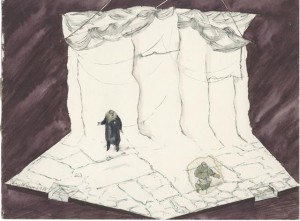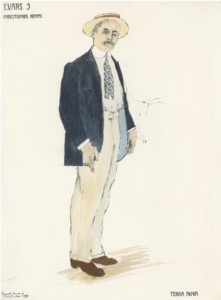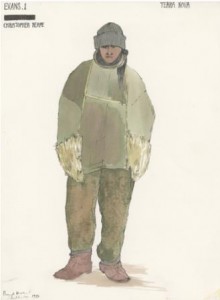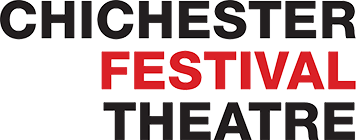
Over the summer Creative Arts student Alice Du Port spent time researching and exploring her interest in Theatre Design by delving into the items in our archives. During this time Alice also had the opportunity to talk with world renowned scenographer Pamela Howard who explained more about her designs for the 1980 production of Terra Nova, staged at Chichester;
In the summer of 1980, Chichester Festival Theatre’s main stage was transformed into a barren ice land, representing the stark and freezing Antarctic, for Ted Tally’s Terra Nova. In the archives is a selection of Pamela Howard’s designs for her Chichester Festival Theatre productions; including this one.
Set in the winter of 1911, Terra Nova tells the story of Captain Scott’s last expedition to the Antarctic in the hope of defeating his Norwegian rival, Amundsen. The story is derived from the letters and journals that were found on Scott’s frozen body, and culminates with the famous self-sacrifice of Captain Oates and Scott’s last journal entry. This was a surprising production to be mounted in mid-summer in the south of England, however, the play continues to be one of the most remembered of the 1980 season. The impact of set designer Pamela Howard’s simple but dramatic staging left the audience members shivering.

Set designers are required to establish a visual language that bridges the gap between the script and the audience. They are responsible for the aesthetic of the project, as well as the often complex logistics of staging. Live theatre requires the designer to have a creative edge, to be able to play to the audiences imagination, and to use props in real, unedited, and live situations. Pamela Howard believes that theatre shouldn’t be a metaphor; it shouldn’t re-create reality, but rather evoke a feeling of reality. For Terra Nova, the stage was simple, and the psychology of the audience was put to the test. Howard managed to acquire sheets of unwanted white muslin backstage, and draped them over the back of the stage, letting them fall to the floor like ice drifts, as shown in Image 1. It is the audiences imagination that Howard’s design is aimed at.
Context is a major point when considering the design of the set. Howard’s stage designs are not drawn in technical detail, but rather with a sense of atmosphere, and with characters already placed as you can see in Image 1. The approach that Howard took in Terra Nova required the audience to use their imagination.
Many of Howard’s costume drawings involve the character with a prop, and most importantly, are set within the context of the play. An essential element of design, in Howard’s opinion, is character. She needs to know the character in context – their personality, habits, back story, future – to be able to gain a sense of who that person is. Costume design here is much more than clothing.

The characterisation of Petty Officer Edgar Evans, for instance, changes dramatically with the wardrobe. Evans joined the Royal Navy in 1891, and Howard’s drawing of him dressed in smart jacket and trousers (Image 2), perhaps echoes his military lifestyle. He joined Captain Scott’s first Antarctic expedition in Discovery in 1901, and was then chosen to join the Terra Nova polar party. He was described by Scott as having ‘resourcefulness, strength and a fund of anecdotes.’ As the team was nearing the pole, Evans cut his hand, and the wound never properly healed. Mentally and physically deteriorating due to frostbite, he became comatose, and was taken to a base camp where he died. Howard’s drawing (Image 3) perhaps show him resigned to his fate. When Evans is shown in expedition clothing, his head is lowered and his shoulders are slouched; all in complete contrast to the Evans before the trip.
For Howard, simplicity is too often ignored in this age of technology and special effects. It is the use of naturalism in her designs that made the production of Terra Nova stand out in the eyes of many audience members.


